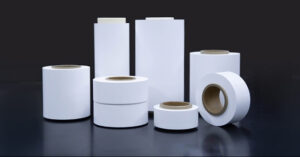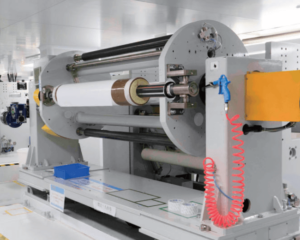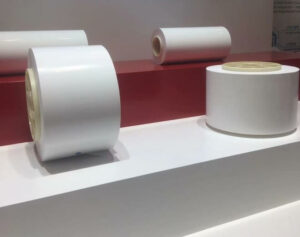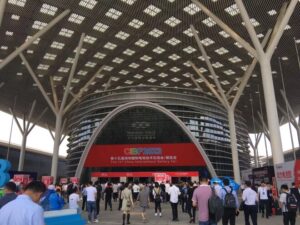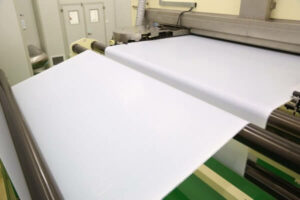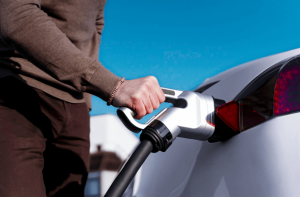Battery separators are thin, porous membranes between a battery’s positive and negative electrodes. Their primary function is to prevent the electrodes from coming into direct contact while allowing the transport of ions between them.
Traditionally, separators were made of porous polymeric materials that offered basic insulation and physical separation between the electrodes. However, as battery technologies advanced, the limitations of these conventional separators became apparent.
Functional coatings were developed to enhance the overall performance of battery separators. These coatings are applied to the surface of the separator material. They can provide additional functionalities such as improved thermal stability, higher ionic conductivity, enhanced mechanical strength, and self-healing properties. They act as a protective layer that improves the battery’s safety, lifespan, and efficiency.
Functional coating for battery separators is an innovative solution that has revolutionized the performance and safety of modern batteries. There is increasing demand for high-energy and long-lasting batteries in various industries, including electric vehicles, portable electronics, and renewable energy storage.

PE base film
Market Trend of Battery Separator Coating
The functional coated battery separators market has been experiencing significant growth in recent years. The demand for high-performance batteries, driven by various industries such as automotive, electronics, renewable energy, and grid storage, has propelled the market forward. Functional coated separators improve battery performance, safety, and longevity.
The market is witnessing a surge in the adoption of ceramic coated separators, as they offer enhanced thermal stability, mechanical strength, and resistance to chemical degradation. Alumina and Boehmite coatings are particularly popular in applications that require high-temperature performance, such as electric vehicles and energy storage systems.
Additionally, there is increasing interest in other functional coatings, such as PVDF, which offer improved electrolyte wettability, enhanced electrochemical performance, and compatibility with various battery chemistries.
In 2022, China’s lithium-ion battery separator shipments reached 12.4 billion square meters. Coated battery separators accounted for 70% of total lithium battery separator shipments. Among the coated battery separators, inorganic coatings (Alumina and boehmite) accounted for more than 90%.
The market is driven by factors such as the rising demand for electric vehicles, the growing need for reliable energy storage solutions, and the continuous advancements in battery technology. The increasing focus on sustainability and the transition to clean energy sources drive the functional coated battery separators market.
As the battery industry continues to evolve, the market for functional coated separators is expected to grow significantly, with innovations in coating materials, manufacturing processes, and performance enhancements.
Types of coating materials for Battery Separators
To enhance their performance and safety, battery separators, known as base films, often undergo coating processes using various materials. There are organic coating (Alumina(Al₂O₃), boehmite) and inorganic coatings (PVDF, Aramid) for battery separators.
Among the most popular coating materials for battery separators are Alumina(Al₂O₃), boehmite, polyvinylidene fluoride (PVDF), and composite coating such as Ceramic + PVDF coating. This article will explore these three coating materials’ significance in battery separator applications.

Composite coating: PVDF+Alumina
These coating materials enhance battery separator performance by improving their thermal stability, mechanical strength, and resistance to electrolyte penetration. Furthermore, they contribute to the overall safety and efficiency of rechargeable batteries.
In the following sections, we will delve deeper into the characteristics, advantages, and applications of Alumina, boehmite, and PVDF coatings for battery separators, shedding light on their importance and ongoing advancements in the field of battery technology.
Alumina coated battery separators
Ceramic coatings, such as Alumina (Al2O3), have gained prominence due to their exceptional thermal stability, high porosity, and resistance to electrolyte solvents. These characteristics make Alumina-coated battery separators well-suited for high-temperature and high-power applications, ensuring the safety and longevity of batteries.

Alumina(AI2O3) coated
Benefits of Alunima Coating
Alumina coating offers several benefits for battery performance and safety. Here are some key advantages of Alumina-coated separators:
Enhanced Thermal Stability
Alumina materials have excellent thermal stability, making them highly suitable for applications with high operating temperatures. Coating the separator with a thin layer of Alumina material significantly improves the separator’s resistance to heat. Alumina coating helps to mitigate the risk of thermal runaway and thermal degradation, making the battery more stable and safe, particularly in high-performance or high-energy applications.
Improved Safety
Alumina coatings can provide a high degree of protection against internal short circuits within the battery. The Alumina layer acts as a physical barrier that prevents direct contact between the electrodes, minimizing the possibility of short circuits and associated safety hazards. This feature is especially crucial in lithium-ion batteries, where short circuits can lead to thermal runaway and potential fires or explosions.
Increased Mechanical Strength and Puncture Resistance
Alumina coatings can enhance the mechanical strength and puncture resistance of battery separators. The Alumina layer adds a protective barrier that helps to prevent the separator from being damaged during assembly, handling, or operation. This improved mechanical strength contributes to the overall durability and lifespan of the battery.
Enhanced Electrochemical Performance
Alumina coatings can improve the ionic conductivity of the separator material. The Alumina layer helps to create a more uniform and stable electrolyte interface, facilitating better ion transfer between the electrodes. Therefore, it improves battery performance, including higher energy efficiency, faster charging/discharging rates, and reduced internal resistance.
Resistance to Chemical Degradation
Alumina coatings can resist chemical degradation caused by the battery’s electrolyte. They act as a protective barrier, preventing the diffusion of reactive species that can degrade the separator material. Alumina coating enhances the stability and longevity of the separator, leading to improved cycling performance and extended battery life.
In summary, Alumina-coated separators offer enhanced thermal stability, improved safety through short-circuit prevention, increased mechanical strength and puncture resistance, improved electrochemical performance, and resistance to chemical degradation. These benefits make Alumina-coated separators highly desirable for high-performance batteries in electric vehicles, grid-scale energy storage, and portable electronics.
Application of Alumina coated battery separators
Alumina-coated separators find application in various battery systems where their unique properties can enhance performance, safety, and durability. Here are some notable applications of Alumina-coated separators:
Lithium-ion Batteries:
Alumina-coated separators are extensively used in lithium-ion batteries, prevalent in portable electronics, electric vehicles, and grid-scale energy storage. The Alumina coating enhances thermal stability, improves safety by preventing internal short circuits, and provides mechanical strength to the separator. These benefits contribute to lithium-ion batteries’ overall performance, reliability, and safety.
High-Temperature Batteries:
Alumina-coated separators are well-suited for high-temperature battery applications. These batteries are used in environments with elevated temperatures, such as aerospace, defense, and industrial applications. The Alumina coating enhances the thermal stability of the separator, allowing it to withstand higher temperatures without degradation or thermal runaway. Alumina coating contributes to the safety and longevity of high-temperature batteries.
Energy Storage Systems:
Alumina-coated separators are utilized in large-scale energy storage systems, such as renewable energy integration and grid stabilization. These systems require batteries with high energy density, long cycle life, and excellent safety. Alumina-coated separators provide:
- The necessary thermal stability.
- Improved safety.
- Enhanced mechanical strength to meet the demanding requirements of energy storage applications.
Specialty Batteries:
Alumina-coated separators also find application in specialty battery systems, including those used in medical devices, aerospace equipment, and deep-sea applications. These batteries often require exceptional safety, reliability, and performance in extreme conditions, and Alumina-coated separators provide the necessary protection and stability to ensure optimal battery operation.
Overall, Alumina-coated separators are extensively utilized in lithium-ion, solid-state, high-temperature, energy storage systems, and specialty battery applications. Their thermal stability, improved safety, mechanical strength, and other beneficial properties make them valuable components in various battery systems across different industries.
Boehmite Coated Battery Separators
Boehmite, an aluminum oxide hydroxide (γ-AlOOH), is another popular coating material for battery separators. It offers excellent thermal stability, chemical resistance, and high mechanical strength. Boehmite coatings help enhance the stability of battery separators by preventing the penetration of electrolytes, thereby reducing the risk of short circuits and enhancing overall battery performance.

Boehmite(γ-AlOOH) coated
Benefits of Boehmite-Coated Separators
Boehmite-coated separators refer to battery separators coated with a layer of boehmite, an aluminum oxide hydroxide (AlOOH) compound. This functional coating provides several benefits and finds applications in various battery systems. Here are some key advantages and applications of boehmite-coated separators:
Enhanced Thermal Stability
Boehmite coatings improve the thermal stability of battery separators, particularly in high-temperature environments. The boehmite layer acts as a thermal barrier, reducing thermal degradation risks and runaway reactions. Thus, it enhances the overall safety and stability of the battery.
Improved Electrochemical Performance
The boehmite coating enhances the ionic conductivity of the separator material, enabling more efficient ion transport between the electrodes. Boehmite coating reduces the internal resistance, improves power output, and higher energy efficiency. The enhanced electrochemical performance translates into better battery performance and extended operational lifespan.
Puncture Resistance and Mechanical Strength
The boehmite coating adds mechanical strength to the separator, making it more resistant to punctures or physical damage. It improves the structural integrity of the separator, thereby reducing the risks of separator failure or short circuits caused by external impacts.
Resistance to Chemical Degradation
Boehmite coatings resist chemical degradation, protecting the separator from interactions with the battery’s electrolyte. It prevents the degradation of the separator material and helps maintain its structural and functional integrity over time, resulting in improved cycling stability and prolonged battery life.
Application of Boehmite-Coated Separators
Lithium-ion Batteries:
Boehmite-coated separators are commonly used in lithium-ion batteries, where they enhance the safety, thermal stability, and electrochemical performance of the battery. They find applications in various industries, including portable electronics, electric vehicles, and energy storage systems.
Other Battery Systems:
The benefits of boehmite-coated separators also extend to other types of battery chemistries. They can be employed in nickel-metal hydride (NiMH) batteries, nickel-cadmium (NiCd) batteries, and other emerging technologies.
In summary, boehmite-coated separators offer enhanced thermal stability, improved electrochemical performance, puncture resistance, and resistance to chemical degradation. These advantages make them valuable in various battery systems, primarily lithium-ion batteries, sodium-ion batteries, and other battery chemistries.
PVDF coated battery separators
PVDF, a polymer coating material, has been widely utilized for battery separators. Polyvinylidene fluoride exhibits excellent thermal stability, chemical resistance, and high mechanical strength. Its low surface energy also aids in preventing electrolyte penetration, improving the separator’s stability and safety.

Water-base PVDF coated (micro-gravure rolling method)
Benefits of PVDF -Coated Separators
PVDF (polyvinylidene fluoride) coated separators are battery separators coated with a layer of PVDF polymer. This functional coating offers several benefits and finds application in various battery systems. Here are the key benefits and applications of PVDF-coated separators:
Enhanced Electrochemical Performance
PVDF coatings can improve the wetting properties of the separator, allowing for better electrolyte infiltration and improved ion transport between the electrodes. This results in lower internal resistance, higher ionic conductivity, and improved battery electrochemical performance.
Improved Mechanical Strength
PVDF coatings enhance the mechanical strength of the separator, making it more resistant to deformation or damage during battery assembly, handling, and operation. This increased mechanical strength contributes to the overall durability and lifespan of the battery.
Chemical Resistance
PVDF coatings provide excellent chemical resistance, protecting the separator from degradation caused by the battery’s electrolyte or other reactive species. This resistance helps maintain the integrity of the separator, ensuring long-term stability and improved cycling performance.
Binder Compatibility
PVDF coatings have good compatibility with various binders used in electrode formulations. It enables better adhesion between the separator and the electrodes, improving the overall structural stability and preventing electrode delamination during battery operation.
Application of PVDF -Coated Separators
Lithium-ion Batteries:
PVDF-coated separators are widely used in lithium-ion batteries, commonly found in portable electronics, electric vehicles, and energy storage systems. The improved electrochemical performance, mechanical strength, chemical resistance, and thermal stability offered by PVDF coatings contribute to the safety and performance of lithium-ion batteries.
Lithium Polymer Batteries:
PVDF-coated separators are also used in lithium polymer batteries with a gel-like electrolyte. The coating helps improve the gel electrolyte’s stability and prevents its leakage or drying out, ensuring the long-term functionality of lithium polymer batteries.
Specialty Batteries:
PVDF-coated separators are employed in specialty battery applications, such as medical devices, aerospace equipment, and military applications. These batteries often require high performance, safety, and stability in demanding conditions, and the PVDF coating helps meet those requirements.
Energy Storage Systems:
PVDF-coated separators are utilized in large-scale energy storage systems for renewable energy integration and grid stabilization. These systems require durable and efficient batteries, and PVDF coatings contribute to energy storage systems’ improved performance and longevity.
In summary, PVDF coated separators offer enhanced electrochemical performance, improved mechanical strength, chemical resistance, thermal stability, and binder compatibility. They find applications in lithium-ion batteries, lithium polymer batteries, specialty batteries, and energy storage systems, where their beneficial properties contribute to the overall performance, safety, and reliability of the batteries.
Comparison of Ceramic, Boehmite, and PVDF Coatings
Generally, coating materials can be classified into inorganic and organic types. Inorganic materials mainly include ceramics (boehmite-AlOOH, alumina-Al2O3), while organic materials mainly include PVDF, aramid, and others.
Alumina coating, Boehmite coating, and PVDF (Polyvinylidene fluoride) coating are three commonly used methods for enhancing the performance and functionality of battery separators. Let’s compare these coatings based on various factors:
1. Material Composition:
– Alumina Coating: Alumina Coating typically consists of ceramic Alumina (Al2O3) particles. These particles provide mechanical strength and thermal stability to the battery separators.
– Boehmite Coating: Boehmite, an aluminum oxide compound, is the primary material for coating battery separators. It offers excellent chemical resistance and thermal stability.
– PVDF Coating: PVDF, a fluoropolymer, is the coating material. It provides high dielectric strength, chemical resistance, and good adhesion properties.
2. Coating Performance:
– Alumina Coating: It offers the battery separators excellent thermal stability, mechanical strength, and dimensional stability. It also provides high resistance to thermal degradation and improved safety.
– Boehmite Coating: Boehmite coating enhances the separators’ mechanical strength, chemical resistance, and thermal stability.
– PVDF Coating: PVDF coating provides excellent chemical resistance, high dielectric strength, and good adhesion strength to the battery pole plate. It enhances the overall stability and performance of batteries. PVDF coating can improve the hardness of pouch cells, which is suitable for assembling.
3. Manufacturing Process:
– Alumina Coating: Alumina coating is typically applied using micro-gravure rolling coating equipment. These processes require specialized equipment and can be more complex.
– Boehmite Coating: Boehmite coating can be applied using various methods such as micro gravure or spray coating.
– PVDF Coating: PVDF coating applied by the rotary spraying and miro-gravure rolling method has matured and was widely used in large-scale LIB for EVs, energy storage batteries, and other large square batteries.
4. Cost:
– Alumina Coating: Alumina coatings can be less expensive due to the coating technology of alumina materials being very mature and the material cost is relatively low.
– Boehmite Coating: Boehmite coating is even more cost-effective than alumina coatings as the material is relatively affordable and the manufacturing processes are simpler.
– PVDF Coating: PVDF coatings are still the most expensive among the three coating materials due to the affordability of PVDF materials.
In summary, Alumina coating, Boehmite coating, and PVDF coating offer unique advantages for battery separators. It’s important to note that the application of these coatings may vary based on the specific battery technology, desired performance requirements, and battery design. Additionally, different combinations and variations of these coatings may be used to optimize the performance of battery separators for different applications.
How to choose the right functional coating for battery separators?
Choosing the right functional coating for battery separators requires considering several factors to meet the specific requirements of the battery system. Here are some key considerations when selecting a functional coating:
Battery Chemistry: Different battery chemistries have unique characteristics and requirements. Consider the specific chemistry of your battery, such as lithium-ion, solid-state, or sodium-ion, and determine which functional coating aligns best with its chemistry and electrolyte system.
Performance Enhancement: Identify your desired performance improvements for your battery system. For example, if you need to enhance conductivity, look for improved ionic or electronic conductivity coatings. If safety is a priority, consider coatings with flame retardant or thermal stability properties.
Compatibility: Ensure that the functional coating is compatible with the other components of the battery system, such as electrodes, electrolytes, and binders. Compatibility issues can lead to reduced performance or even failure of the battery.
Application Environment: Consider the operating conditions in which the battery will be used. Factors such as temperature range, humidity, chemical exposure, and mechanical stress should be considered. Select a coating that can withstand these environmental factors and provide the necessary protection.
Manufacturing and Cost: Evaluate the feasibility and cost-effectiveness of applying the functional coating during battery manufacturing. Consider factors such as ease of application, scalability, and cost of the coating material.
Safety Considerations: Assess the safety aspects of the functional coating, especially if the battery will be used in applications where safety is critical, such as electric vehicles or medical devices. Look for coatings that provide features like thermal stability, flame retardancy, or self-healing capabilities.
Research and Testing: Stay updated with the latest research and developments in functional coatings for battery separators. Conduct thorough testing and analysis of different coatings to evaluate their performance and compatibility with your battery system.
It is essential to consult with experts and researchers in battery technology and functional coatings to ensure you make an informed decision. Conducting proper research, evaluating the specific requirements of your battery system, and considering the factors mentioned above will help you choose the most suitable functional coating for your battery separators.
In conclusion, three popular coatings for battery separators are ceramic coatings, boehmite coatings, and PVDF coatings.
Ceramic coatings(Alumina and Boehmite) offer enhanced thermal stability, improved safety, and increased mechanical strength, making them ideal for high-temperature applications.
PVDF coatings enhance electrochemical performance, mechanical strength, chemical resistance, and binder compatibility, making them widely used in lithium-ion batteries and energy storage systems.
Choosing the right coating depends on the specific requirements of the battery system, such as chemistry, performance enhancement needs, and application environment. Thorough research, testing, and consultation with experts are crucial in selecting the appropriate coating for battery separators.


